
The Trocadero Theatre is a historic theater located in Chinatown in Philadelphia, Pennsylvania. It offered musical comedies, vaudeville, opera, and burlesque. The Trocadero Theatre was refurbished for use as an art house cinema and fine arts theatre in 1970s, and by the 1990s had become an iconic venue for rock and punk concerts.
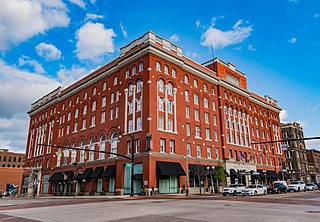
The Great Southern Hotel & Theatre is an historic hotel and theater building in Downtown Columbus, Ohio. The building currently operates as the Westin Great Southern Columbus and the Southern Theatre.

The State Theatre, officially known as the State Theatre Center for the Arts, is a 1,500-seat, historic, American theater that is located in the City of Easton, Northampton County, Pennsylvania.

Colonial Theatre, also known as the Lochiel Hotel, is a historic theater and commercial building located at Harrisburg, Dauphin County, Pennsylvania. The building consists of a five-story, brick and frame front section and a rear brick and frame auditorium. The original Colonial Theatre was built about 1836, as a hotel in the Greek Revival style and featured a four columned portico on the Market Street entrance. It was subsequently modified in form and use a number of times. In the 1870s, a mansard roof was added. The rear auditorium was added in 1912, when the building was converted from a hotel to hotel and movie / vaudeville theater. The lobby was remodeled in the 1930s / 1940s in an Art Deco style; the auditorium has Italian Renaissance style detailing. The theater and hotel closed in 1976, and the building used for offices and shops.
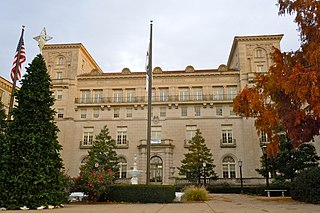
The Hershey Community Center Building is an historic building which is located in Hershey, Dauphin County, Pennsylvania.

The Johnstown Flood Museum is a history museum located in Johnstown, Pennsylvania, dedicated to the Johnstown Flood of 1889. The museum is housed in the former Cambria Public Library, which is part of the Downtown Johnstown Historic District.

Miller's Store, also known as the Trent House and General Store and the Trenthouse Inn and Country Store, is an historic, American commercial building that is located in Trent in Middlecreek Township, Somerset County, Pennsylvania.

The Penrose Wolf Building, also known as the Rockwood Opera House, is an historic, American commercial building that is located in Rockwood, Somerset County, Pennsylvania.

The Star Junction Historic District is a national historic district that is located in Perry Township, Fayette County, Pennsylvania.

The F. M. Kirby Center is a historic Art Deco-Moderne style movie theater located at Wilkes-Barre, Pennsylvania. It was added to the National Register of Historic Places in 1980.

Ross Common Manor is a national historic district that is located in Ross Township, Monroe County, Pennsylvania.

The Oil City South Side Historic District, also known as Venango City and Laytonia, is a national historic district that is located in Oil City, Venango County, Pennsylvania, and is situated directly south of the Oil City Downtown Commercial Historic District.

The Mount Pleasant Historic District is a national historic district that is located in Mount Pleasant, Westmoreland County, Pennsylvania.

The New Kensington Downtown Historic District, also known as the New Kensington Commercial and Residential Historic District, is a national historic district that is located in New Kensington, Westmoreland County, Pennsylvania.
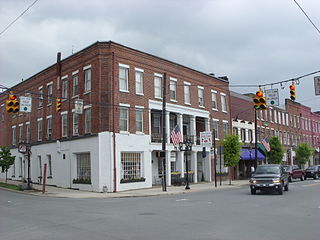
The Tunkhannock Historic District is a national historic district that is located in Tunkhannock, Wyoming County, Pennsylvania.
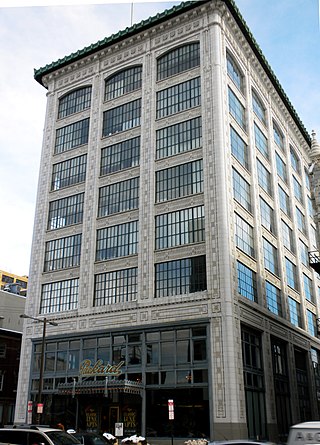
The Packard Motor Car Company Building, also known as the Press Building, is an historic, American office building that is located at 319 North Broad Street between Pearl and Wood Streets in the Callowhill neighborhood of Philadelphia, Pennsylvania.
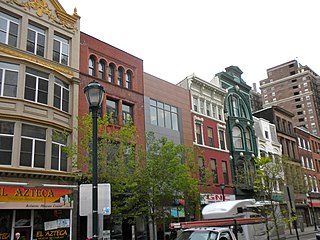
The East Center City Commercial Historic District is a national historic district located in the Washington Square neighborhood of Philadelphia, Pennsylvania. It encompasses 287 contributing structures, including large and small commercial buildings, banks, hotels, newspapers, clubs, and restaurants.

The Titusville Historic District is a national historic district that is located in Titusville, Crawford County, Pennsylvania.

The William Everhart Buildings, also known as the Everhart-Lincoln Building, is an historic, American commercial building complex that is located in West Chester, Chester County, Pennsylvania.

The Montrose Historic District is a national historic district located in Montrose, Susquehanna County, Pennsylvania. The district encompasses 386 contributing buildings and two contributing sites in the central business district and surrounding residential areas of Montrose.
























